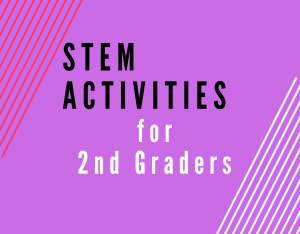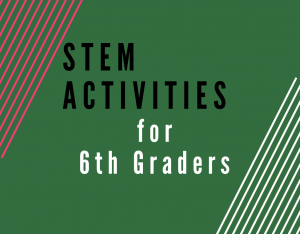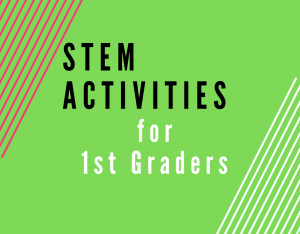STEM activities for fourth graders may be difficult to find, mainly because most are described as being aimed towards at least two other grades. When aligned with current teachings, STEM activities can dramatically advance knowledge and understanding of concepts.
To facilitate an effective and engaging STEM activity, STEM subjects should naturally connect while students have fun doing them. Often, students will not even acknowledge they are learning, but the knowledge will stay with them for a long time.
I chose these activities because they combine and teach multiple STEM subjects that are naturally used together while aligning with fourth-grade level Next Generation Science Standards (NGSS). And, of course – they are all fun and exciting for teachers and fourth graders!
Table of Contents
Moon Thermos Design Challenge
Materials
- 2 glow sticks
- plastic cups
- graduated cylinders
- stopwatches
- thermometers
- Insulation Materials:
- styrofoam
- foil
- water
- sand
- cloth
- paper
- bubble wrap
Description
Students will be designing an insulator that will keep water at a relatively steady temperature. This activity’s objective is to demonstrate an understanding of the Engineering Design Process (EDP) while using each stage to complete a team challenge successfully.
Fourth graders usually respond well to some NASA motivation. Ask them if they ever wondered what was involved in designing modern spacesuits then have them check out this page on NASA’s website:
https://www.nasa.gov/audience/foreducators/spacesuits/home/clickable_suit_nf.html
To help fourth-graders understand the concept, let them pretend to be molecules. In an open space, have the students stand close together. Next, ask them to wiggle as they walk and move around, demonstrating more heat energy entering the system. As more heat energy enters the system, have them move faster and jump up and down. Tell the students to stop and notice where they are standing. They should naturally be further apart from each other and should feel warmer than they were at the beginning. Finally, place a glow stick in a clear cup of cold water and another one in a clear cup of hot water, then turn the lights off. Ask the students to pick the glow stick that has more molecular movement.
Challenge the students to design a “Moon Thermos,” asking them to devise an insulation system that holds a cup of cold water and a cup of hot water at a constant temperature:
- Provide the students with the insulation materials and using any combination, have them create a protective insulating layer that keeps 100 ml of cold water, and 100 ml of hot water at a relatively constant temperature.
- Tell them that their “Moon Thermos” temperatures should not change any more than 3 degrees celsius within five minutes.
- Using a graduated cylinder, have them pour the amounts of cold water into one plastic cup and repeat for hot water from the tap.
- Place a thermometer in each cup.
- On the stopwatch, set the timer to go off every 30 seconds for 5 minutes total.
- For every thirty seconds, have students record the temperature.
- In a second trial, allow the students to improve their design by trying another combination of materials.
- Have the students graph the results.
Using the EDP to create an insulator is a scientific experiment that requires a control. To allow students to compare their data, first record the temperature of the room. Place an un-insulated cup of cold water and an un-insulated cup of hot water at the front of the room while students test their cups. Record the temperatures for every thirty seconds. Use this data to share with the students.
Science Content
This activity aligns with NGSS:
4-PS3-2: “Make observations to provide evidence that energy can be transferred from place to place by sound, light, heat, and electric currents”
3-5-ETS1-1: “Define a simple design problem reflecting a need or a want that includes specified criteria for success and constraints on materials, time, or cost.”
Engineering Content
Students are asked to use the Engineering Design Process in keeping water at a constant temperature. Before beginning, students should discuss their experience and understanding of how insulators work. Asking how their soup stays warm in their thermos or how their water stays cold in a thermos are excellent discussion starters. Students are then asked to start their planning and design using limited materials given to them by their teacher. It is important to allow the students to redesign trying other combinations of materials for the second trial.
Math Content
Creating graphs is optional, depending on your state’s standards. On the graphs for this experiment, the independent variable is time – plotted on the x-axis, while the dependent variable is the temperature of the water – plotted on the y-axis.
What to Say and Ask
How did the temperature of the cold water change?
How did the temperature of the hot water change?
Did the temperatures change in your second trial? If so, what caused that in your redesign?
Looking at your experiment’s data, how did it compare to my control experiment?
Source
https://www.nasa.gov/pdf/630753main_NASAsBESTActivityGuide3-5.pdf
Straw Rocket
Materials
- drinking straws
- eye protection
- fat, round pencil or dowel
- meter stick or tape measure
- ruler
- scissors
- cellophane tape
- sheet of 8.5 x 11 paper (white or colored)
Description
In this STEM activity for fourth graders, students build a paper rocket and investigate to improve their travel distance. Students should be allowed the time working with balanced and unbalanced forces to align with performance expectations
One of the most important issues for rocket scientists is rocket stability. For a space launch to be successful, it depends on high accuracy. If a NASA Space Launch System rocket reaches the wrong orbit in space, fuel or supplies may not be enough to make it back.
Stability means ensuring a rocket follows a smooth flight path. The roughness of wobbly rides will burn extra fuel to get back on course. A tumbled rocket means the destruct button must be pressed because an unstable rocket is dangerous.
Fortunately, ensuring stability when traveling through the atmosphere is relatively easy if two things are remembered: center of mass and center of pressure. Center of mass (COM) is the balance point of a rocket. Center of pressure (COP) is the balance point of the pressure exerted on the surface of the rocket by air molecules as it flies through the air.
How To
- Show students how to construct the rockets.
- Cut and 4 cm wide by 28 cm long strip of paper for the rocket body.
- Roll the strip around a pencil to form it.
- Tape both ends to keep its form.
- Make a nose cone by closing off one end.
- Cut out three or four fins.
- Tape the fins to the open end of the rocket then bend them outward with equal space between them.
- Have the students construct their rockets, then show them how to check for stability by performing drop tests:
- Drop the rocket to the floor from the eye level. The nose of the rocket hitting the floor first means that the rocket is stable and ready to fly. The rocket falling horizontally or the fin end hitting first means the rocket is unstable. Stabilizing the rocket may require larger fins. Have the students perform their stabilization tests, making adjustments if needed.
- Show the students how to launch the rocket. Insert a straw into the end opening of the rocket body. Aim the rocket and puff hard into the straw.
- Hold distance trials to allow students to improve their rocket design. Students will find the average travel distance from three launches. To get more distance, they will try to improve their rocket design.
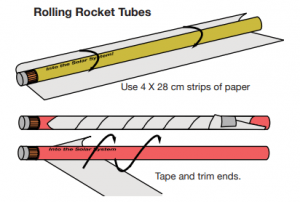
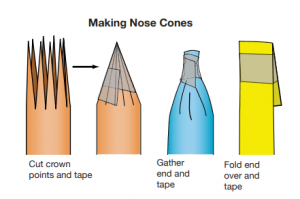
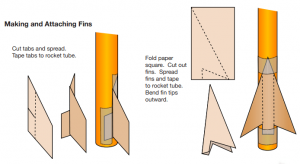
If this way seems too complicated for your students, here’s a video showing an easier way:
Science Content
This STEM activity for fourth graders aligns with several National Science Content Standards and Next Generation Science Standards.
National Science Content Standards:
- Unifying Concepts and Processes – Evidence, models, and explanation
- Science as Inquiry – Abilities necessary to do scientific inquiry
- Physical Science – Position and motion of objects and motions and forces
- Science and Technology – Abilities of technological design
Next Generation Science Standards:
- 3-PS2-1 – “Plan and conduct an investigation to provide evidence of the effects of balanced and unbalanced forces on the motion of an object.”
- 3-5-ETS1-2 – “Generate and compare multiple possible solutions to a problem based on how well each is likely to meet the criteria and constraints of the problem.”
Engineering Content
This STEM activity for fourth graders uses a straw rocket test report where students record their measurements after launching their rockets. The data they collect is used to redesign their rockets to improve distance. Students should reflect on what they did differently by writing and/or drawing pictures of their changes in their journals.
Math Content
This STEM activity for fourth graders aligns with several National Mathematics Content Standards and National Mathematics Process Standards.
National Mathematics Content Standards:
- Number and Operations
- Geometry
- Measurement
- Data Analysis and Probability
National Mathematics Process Standards:
- Connections
- Representations
What to Say and Ask
- I just dropped a book on the floor. Why did it fall? What caused it to stop falling?
- If you made a paper airplane, what can you do to make it fly without tossing it using your hands?
- Would the plane keep going forever? What would make it stop?
- What can you do to improve your rocket travel distance?
- Did your changes improve the rocket’s flight?
Bonus Resource Hint:
http://www.rockets4schools.org/images/Basic.Rocket.Stability.pdf
Source
https://www.nasa.gov/pdf/153413main_Rockets_3_2_1_Puff.pdf
Solar Water Heater
Materials
- an indoor-outdoor digital thermometer that can read tenths of a degree
- duct tape
- straws
- scissors
- ruler
- pitcher of water
- 3 feet (0.9 m) clear plastic tubing (Outside diameter: ¼ inch /6 mm)
- 2 paper cups (medium-sized)
- black paper
- black marker
- gooseneck lamp with an indoor 100-watt floodlight light bulb (optional if using sunlight)
- large sheet of cardboard (e.g., 11 x 17 inches/ 28 x 43 cm)
- aluminum foil
Description
In this activity, students use the Engineering Design Process (EDP) to build a solar water heater and see how big of a temperature change they can get. It is designed around how astronauts will need buildings that can protect them from the moon’s freezing temperatures to survive long stays on the moon.
Some places near the moon’s poles get a steady supply of sunshine. This nearly constant supply of sunlight can be used to heat water. Once the water is heated, it can be pumped through a building to heat it.
How To
- Describe to students how some places on the moon can be as low as -250 degrees Fahrenheit, which is colder than Antarctica. To survive on the moon, astronauts will need buildings that can protect them from these temperatures. One way to heat these buildings is to use sunlight to heat water and pump it through the building.
- Demonstrate how to get water to flow through the tube by poking a hole near the bottom of a cup then put the tube into the hole. Set another cup under the end of the tube then test your system with water, sealing any leaks.
- Have students build a water heater using the materials to design a system that can help water absorb heat energy.
- Start with having them keep their heater in strong sunlight or eight inches below the lamp. (SAFETY NOTE: Keep water away from the outlet, lamp, and bulb.)
- Have students measure and record the water’s temperature before going into the supply cup.
- Pour water into the supply cup.
- Record the water temperature as it comes out of the lower end of the tube.
- Ask the students to redesign their system to get a higher temperature, explaining how different materials and time in the tube can affect the temperature of water.
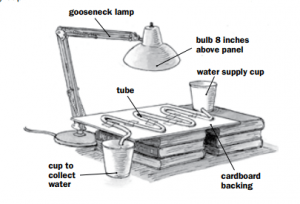
Science Content
This STEM activity for fourth graders align with two Next Generation Science Standards:
3-5-ETS1-3: “Plan and carry out fair tests in which variables are controlled and failure points are considered to identify aspects of a model or prototype that can be improved.”
4-PS3-4: “Apply scientific ideas to design, test, and refine a device that converts energy from one form to another.”
Technology Content
Students build a gravity-fed water system – When the supply cup is placed higher than the collection cup, gravity pulls the water through the solar panel’s tube.
Engineering Content
Students use EDP to design and build a solar water heater. They are encouraged to change and redesign their systems to increase the temperature from the first cup to the second cup after it flows through the tube. Students should have experience with variables and how changing one variable may or may not change their effect on the water. Students should also keep a log of the water’s temperature each time they changed something. Stopwatches are used to time how long the water took to go through the system.
Math Content
Measurement – Kids measure the temperature change, the rate of water flow, and the volume of water.
What to Say and Ask
- Did the speed of water going through the tubes affect the water temperature?
- What can you do to the tubes to have the water take longer to pass through?
- Does the color of the background change the water temperature?
- What would happen if you put aluminum foil around the device?
Source
https://pbskids.org/designsquad/pdf/parentseducators/DS_NASA_08FeelHeat_CS.pdf

